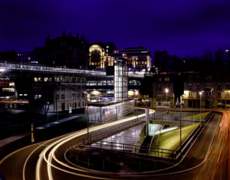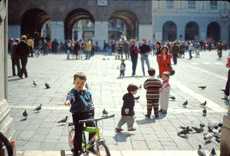Mario Gandelsonas

Traffic in Lausanne -- Photo by Peter Mauss/ESTO, courtesy of Bernard Tschumi Architects.

Piazza in Vicenza
Mario Gandelsonas celebrates the unplanned dynamism of large cities.
The city as a process, as an economic dynamo, a place of both physical and non-physical exchange, has always resisted the suppression of time, of difference, of the contingent, of its reduction to the status of a building; that is, to the spatiality and totalizing nature of the object implied by the architectural urban practice. . . . The city presents to architecture an open play of differences within a potentially infinite field of shapes. Since this field resists closure, the city stands as an obstacle to the architectural effort to domesticating that play, to impose a totalizing order. Gandelsonas1999, 60-61
Gandelsonas may be trying too hard to make the creative city become the post-structuralist play of difference, for that play can never appear as such. But he is right that there is an empirical mix of differences and forces that cannot be overseen and controlled. They mutate and re-individuate and re-combine. Such density and interaction leaps beyond the accepted, with "the contingent, the violent emergence of something that defies the limits of the established field, the limits of what one holds for "possible" (38). He offers as examples of such unexpected changes both the way in which the entry of women into the workforce "shattered the stability of the suburban order," and our current "unexpected massive entrance into the virtual city." But the very examples Gandelsonas cites are of changes and recombinations happening in suburbia. Spatial contiguity is not a necessary condition for the openness and changes he describes.